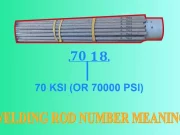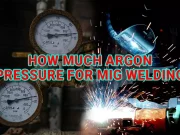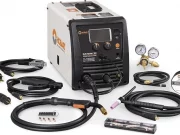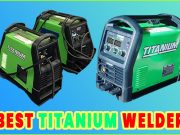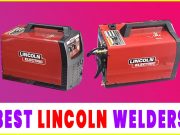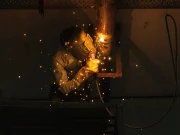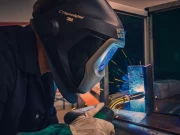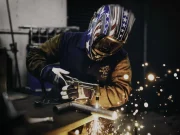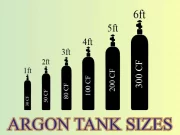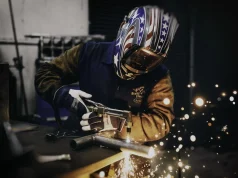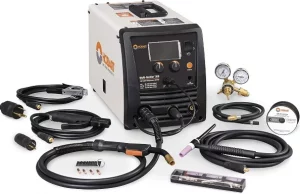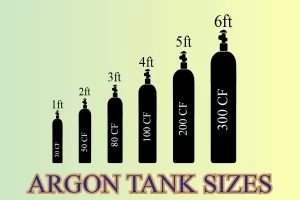
Argon is one of the most abundant gases on earth. The gas has several useful properties that make it perfect in many industrial processes. It is also cheaper to extract than other inert and noble elements in the air.
One of the main industrial uses for argon gas is welding. One of the most important elements of welding is to prevent oxidation.
Oxidation occurs when oxygen ions in the atmosphere combine with reactive metals, forming an oxide layer. It results in rusting and rapid structural deterioration.
Metals are more reactive when hot, as the electrons are easier to displace. Argon solves the issue, as it is stable and unreactive. Argon is sold in cylinders of varying sizes. Today, we explore the different tank sizes.
What Argon Tank Sizes Can You Buy?
There are several tank sizes in the market, based on what you require. These tanks are packed with 99.99% argon gas with slight impurities. Industry-standard tanks are the same across the board, regardless of the branding.
These tanks are mostly used in Tungsten Inert Gas welding and less in Metal inert gas welding.
There are eight industry sizes for these tanks. The tanks vary in capacity, pressure rating, uses, and advantages.
What are the classifications?
1. Type R Tanks
These are the smallest tank’s incapacity. They are ideal for very light-duty welds that require fewer gases.
These tanks are perfect for home projects and other minor joint welds. They are compact and easy to store and transport.
The gas capacity for the tanks ranges from 19 to 21 cubic feet. They are therefore not ideal for heavy-duty tasks. These tanks only weigh 17 pounds, so that you can move them easily within your workshop.
The type R tanks are perfect for job site tasks with only 17 inches in height and 5 inches in diameter. They also cost less than other tanks.
2. RR tanks (Double R Tanks)
RR argon tanks are twice as large as R-type tanks. Just like the Type R tanks, they are ideal light-duty tasks. They are better because of the capacity difference, and they will certainly last longer.
The gas capacity for RR argon tanks ranges from 40 to 44 cubic feet. These tanks are also quite portable. Despite having twice the capacity of Type R tanks, they only weigh five pounds more at 22 pounds.
The Double R tanks have 7 inches and are 21 inches high. They are fairly easy to transport. They aren’t suited for intense tasks.
3. Q1 Size tanks
On the size scale, Q1 tanks are the smallest medium-sized tanks in the market. These tanks are ideal for both light and medium-duty tasks. They are versatile, and you can use them at home for simple welds or in your workshop.
The capacity of Q1 tanks is 65 cubic feet. They will get you through a lot of welding before you run out. The nozzle pressure rating on these tanks is 2015 PSI.
A full tank weighs about 25 pounds. Just like the RR tank, the Q1 tank has a 7-inch diameter. Its height is 24 inches.
4. Size Q argon tanks
Size Q argon tanks are larger mid-sized argon tanks. They can easily handle mid-duty and some heavy-duty tasks.
These tanks have a size of these tanks lie in 80 to 83 cubic feet range. Their pressure rating is similar to that of Q1 tanks at 2015 PSI. While these tanks are okay for home use, they are better suited for workshops.
The Size Q tanks are not portable, for they weigh 73 pounds. These tanks are better suited for use in a fixed location. They have a base diameter of 7 inches and a height of 32 inches.
5. S1 Size tanks
S1 size tanks are the largest mid-sized argon tanks. These tanks are custom built to handle both mid and heavy-duty welding jobs.
These tanks are built to last long with a net capacity of 120 to 125 cubic feet. The tanks have a significant nozzle pressure rating. The 2265 PSI rating means that it can easily handle most heavy-duty tasks.
The tanks have a net weight of 61 pounds at full capacity. The standard diameter is 7.5 inches, while the height is 50 inches. The tank is ideal for workshops that take on substantial workloads. It is a job site tank.
6. S size tanks
Size S tanks are in the large-tier group of argon tanks. These massive tanks are suitable for use in factories or manufacturing plants. They are heavy-duty tanks used with MIG and TIG welders.
Size S tanks have a net capacity of 155 cubic feet. They will be ideal for lengthy welding processes. These tanks work well with automated welding machinery that uses high-precision mechanisms.
Size S tanks weigh 70 pounds at their full capacity. Its diameter is 7.5 inches, and its height is 46 inches. These tanks should be used at a fixed location, as they are not portable.
7. K size tanks
K size tanks are the mid-tier tanks on the large tank spectrum. Like other large tanks, they are suited for heavy-duty machine welding.
Size K tanks have a net capacity of 251 cubic feet. Thanks to their large capacity, these massive tanks are not to be replaced often.
These tanks weigh 158 pounds when they are full. They have an 8.5-inch diameter and a height of 51 inches.
These tanks are massive. They have a 3000 PSI rating, which is more than enough for intensive welding.
The K-size tanks are perfect for use in factories.
8. Type T tanks
These are the largest commercial-grade tanks that you can buy. They are massive and are perfect for use in industrial-level welding.
These tanks have a capacity of 335 cubic feet. They can last more than 20 hours under continuous use. They are designed for industry-level workloads, though you can use them for all sorts of projects.
The tanks are 9.2 inches across and 55 inches high. You will probably need a proper rack when using them.
The tanks weigh 170 pounds, and they are not portable. The PSI ratings on the tanks are typically over 3000.
Argon Tank Safety
No matter the argon tank size you select, you must observe safety when using them. These tanks are helpful in welding, but using them unsafely can have serious consequences.
It would help if you also had the correct attire when welding. Click here to discover the best helmets.
Here is how you can stay safe:
1. Keep the valves on when you aren’t using the tank
You should always ensure that the valves are on to prevent leaks. It applies to every welding tank and not just argon tanks. Leaking argon has serious health consequences for your health and pockets.
If you inhale excessive amounts of argon gas, it will cause nausea, dizziness, and death. Valves keep the tank from inadvertently leaking- they keep you safe.
2. Storage
Storing argon tanks is an important aspect of using these items safely. Ensure that you store your tanks vertically. Storing tanks vertically ensures that argon gas doesn’t separate from acetone.
It would help if you stored tanks away from direct sunlight, as this might cause the gas inside to heat up and expand beyond the tank’s critical capacity. It would help if you also remembered to store them out of the reach of children and pets.
3. Inspection
Before buying an argon tank, you must inspect it thoroughly. Do not purchase tanks with dents, as they are not structurally sound.
Beware of corrosion, especially around the gauge connection points. Corrosion could lead to the tank developing holes, which could have serious consequences.
Lastly, ensure that the tank has no cracks. Cracks that appear superficial could expand rapidly, especially if the tank is not stored correctly.
4. Aluminum over steel tanks
Aluminum tanks have some advantages over steel tanks. What makes aluminum tanks better? Aluminum tanks are less prone to rust, unlike steel tanks which could rust under certain conditions.
Therefore, aluminum has a better expansion threshold and is less likely to develop pressure cracks.
Aluminum tanks are also lighter than steel tanks. You will require less effort moving them about. Click here to discover corresponding aluminum welders.
5. Smoking
One of the most reckless things you could do is smoke around gas tanks. Smoking around argon tanks is dangerous, and it could have serious consequences.
Argon is a noble gas. It is unreactive and does not burn since it is very stable. Argon tanks, however, can explode around flames.
It could lead to severe injuries to the people in the vicinity, or even death if you are struck by shrapnel.
6. Ventilation
Using an argon tank would help if you were in a ventilated room. A well-ventilated room ensures that you have enough oxygen.
Welding consumes a lot of atmospheric oxygen. You might start getting dizzy or nauseous after prolonged welding sessions or if the room is not properly ventilated. Having sufficient ventilation is beneficial to your well-being.
7. Use carts
Do not lift or move the argon tanks without the cart. These tanks need to always stay in an upright position.
Using the cart also prevents you from getting injured. Since these tanks lack grip points, you are likely to drop them if you don’t use the carts.
Choosing The Correct Tank Size
Now that we have seen all the tank sizes, you should choose the one that suits you. How do you select the right tank size? Here are some helpful tips.
Workload
You should select your tank depending on the use case. If you plan to do some light-duty welding around your house, then a type R or a double R will suffice.
It would help if you used Q1, Q, and S1 tanks for light to mid-duty tasks, as they last longer than R or RR-sized cylinders.
The S, K, and T size tanks are ideal for heavy-duty welding.
Portability
Portable tanks are ideal because you can take them to your job location whenever you want. They have a tiny storage footprint, and you can put them in your vehicle.
If you are looking for a tank that you can conveniently take anywhere, the R and RR tanks are perfect.
The disadvantage with using portable tanks is that you would have to replace them frequently due to their small capacity.
Use frequency
Before buying a tank, ask yourself whether or not you often do welding. If welding is something you often do, consider a large tank. In this case, a size S, T, or K tank would do the trick.
If you rarely ever weld but would like to buy a machine just in case, then consider buying the type R or an RR tank.
Welding duration
You should pick your tank size depending on the nature of the welding job. Some welding jobs take time and therefore require more argon to complete. If you are doing jobs that take a lot of time, you should choose tanks in the S, T, or K size.
Some jobs do not require a long time to complete. Joining tiny frames is relatively easy and requires a small welding duration. Consider size R or RR tanks if you do fast and easy welding jobs.
Shop or home use
If you are doing professional-grade welding jobs, you should consider purchasing large tanks. It is more economical for your business. For casual home use, then small and medium-sized tanks are acceptable.
Conclusion
Argon is one of the most useful industrial gases available. It has many great properties that make it ideal for different processes. Argon is also popular because of its abundance and uncomplicated extraction.
Argon is used in welding. It is the ideal gas because it is less reactive and unlikely to induce oxidation even at high temperatures. Argon cylinders vary in size. The smallest tank size in the market is 20 cubic feet. It is perfect for low-intensity and simple welds.
The largest tank you can buy is 300 cubic feet. They last longer and are perfect for high-intensity welds.




